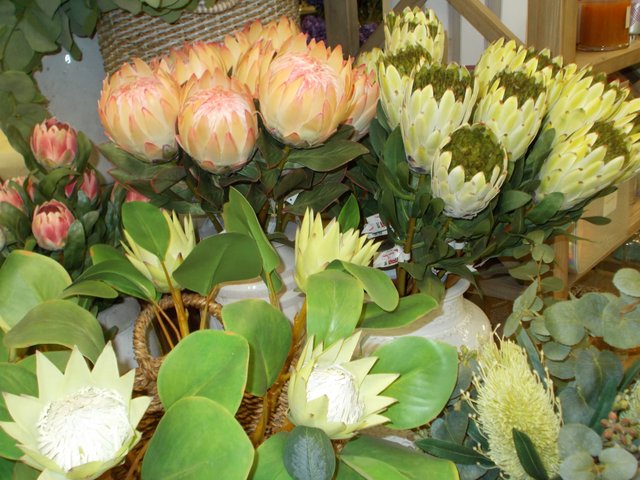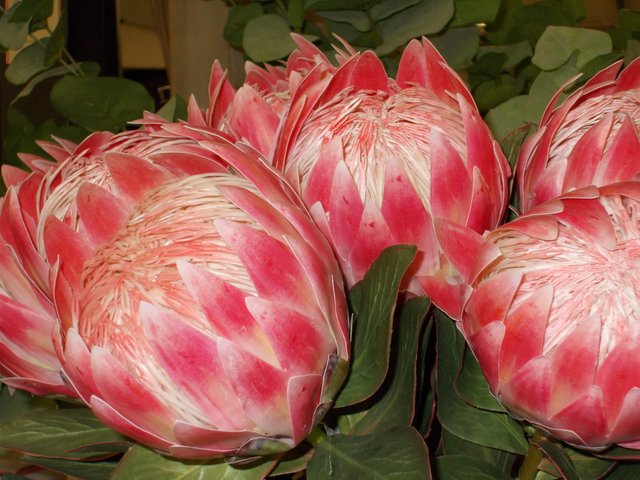Proteas make great cut flowers.
Proteas are native to Africa, and are most well known as a cut flower. The huge colourful blooms are long lasting and spectacular, and come in many shapes and colours. The plants also vary in height from small compact shrubs to large shrubs. They are suited for temperate to warm climates, but it is important to plant them in a sunny position and make sure they have well drained soil. Once established, the plants only require a good occasional watering . The smaller growing varieties are suited to growing in pots or containers. Today, Proteas are grown commercially in many Countries. Your fresh cut Proteas will last a long time if you regularly cut 1 to 2 cm of the bottom of the stems and put them in fresh water. I photographed these cut flowers locally.
100% of New South Wales - the State in Australia where i live - is now officially drought declared. This is huge and should be a big wakeup call to everyone. Why? Because this has NOTHING to do with "Climate Change". This is a man-made drought brought about by the use of Geoengineering (Chemtrails) , and the use of HAARP. The goal is to shut down the food supply and raise food prices, creating hardship for the people. If farmers cannot grow crops or raise Livestock, people don't eat. This is a worldwide phonomenon, not just in my Country. Why should you worry ? Because they are doing this worldwide, and you will be affected. This is weponizing the weather, creating not just drought but also floods. Think i am crazy ? Do your own research, don't take my word for it. Here's where you can start reading about it; www.geoengineeringwatch.org


Protea are excellent additions to any garden. However, not everyone has garden spaces to enjoy them in. There are some varieties which perform excellently in pots and therefore can be enjoyed on a deck or patio. Below are some tips for receiving the best results from growing your Proteaflora plants in pots!
Most Proteas prefer soils that are well-drained and acidic and we suggest avoiding heavy clay soils. If you have a garden with heavy or clay soil, consider improving the drainage by using a free draining garden mix and either creating a raised garden bed (minimum height 30 - 45 cm) or installing underground drainage pipes.
https://www.rbgsyd.nsw.gov.au/visit/things-to-see-do/gardening/growing-proteas
Fav. comment Award !! Great choice of Pics again.
Getty
Striking goblet-shaped creations, they’re an amazing combination of fluffy centres and brightly coloured bracts, which look almost too fabulous to be real. And just as beautiful are the protea’s close cousins, leucadendrons, leucospermums and serrurias, all with incredible flowers that can offer splendid colour to a garden.
Proteas put on a gorgeous display in gardens, mainly through the late winter and spring months. They are tough and hardy evergreen plants, will thrive in exposed positions with poor soils, and are also both heat and cold tolerant (from -6° to 40°).
In terms of their preferred climates, they’ll grow in most regions except for the more humid zones. However, there are two things they won’t negotiate – one is full sun and the other is perfectly free-draining soil. Get those right and you can invite the protea gang to your garden party!
https://www.bhg.com.au/how-to-grow-proteas
Fav. Comment Award !! Great choice of Pics. Well done.
Proteas prefer a nice sandy loam or open soil. Some Proteas are less fussy and are quite happy in a heavier soil although they will not survive in heavy clay soils. If you do have heavy soils it will be necessary to first mound the soil to improve it and then dig in compost and gypsum to break up any residual clay.
pH or the acidity or alkalinity of soils. Plants often grow best where the soil pH is similar to their conditions of origin. Proteas prefer to grow in acidic soils as this reflects the conditions where they originate in South Africa and Australia. The majority of Proteaflora products need an acidic soil with a pH between 5.6 and 6.5. Some of our products do tolerate neutral to alkaline soils with a pH between 6.6 to 7.5. If that's a bit confusing, your local nursery should be able to tell you about your local soil and advise you on testing and treatment, if necessary. Check out the Our Plants page to find the plants best suited for your garden.
http://www.proteaflora.com.au/establishing-your-new-protea.html
Silly Sausage Award !! Wonderful Pics and information.
Thank you for selecting me.
Thank you for posting @ctrl-alt-nwo.
Lovely flowers that previous to your description, there was no name to which to assign these beauties.....thank you.
Man can try what he will and has since time began.....interesting how God lets these things play out......look how things turned out with the Tower of Babel.
Hope you are enjoying some Proteas.....choosing from these colours....would not have been easy.
All the best.
Cheers!
Yes, i think the Lord is going to make sure we learn a lesson, although it may be hard love and a hard lesson. We sure are in for some interesting times ahead.
When I see a jet with a trail of a chemtrail allways say ... that it's a chemtrail, then the guy behind me say "that it's just smoke from the fuel of the airplane" and me.... the jets don't do that, some engineers says... it's just vapor in high altitude... and still don't believe it...
The differnce is that Contrails ( from jet engines ) evaporate quickly behind the plane, just like your breath evaporates quickly after you breathe out on a cold morning. Chemtrails persist in the sky for a long time, and spread out across the sky, creating a sort of soup-like fog type of cloud. Sometimes you can observe the planes turning the sprays on and off again. You cannot do that with Contrails, but you can do it with sprays. It's full of Aluminium in an aerosol form, toxic to all life. The idea is that it reflects sunlight back into space, thus cooling the earth, But the problem is, it also creates a "blanket" that traps the heat in too. It's just an excuse they use for carrying out their goal of "managing" the weather for their goal of carrying out Agenda 21.
Thank you so much @ctrl-alt-nwo
Source
Many people don’t know that the Protea flower is adapted to survive ravaging veld fires. It needs the heat and intensity of fire in order to sustain its species. It produces new growth after a fire and grows back stronger.
The Protea is also named after Proteus, the god in Greek mythology who was adaptable and could change into many forms and do what was needed to survive.
Source
Text Source
Source
It’s really terrifying to think that a tornado could sweep away your home with only a moment’s notice and that earthquakes can trigger tsunami waves that kill hundreds of thousands of people, or drought causing farmers not being able to grow crops or raise Livestock, which undoubtedly leads people to starve.
It’s even more terrifying to imagine that some of this is actually man-made by the use of Chemtrails and HAARP. Just not long ago I read an article about North Korea’s leader admitting use of weather weaponization. Imagine what other countries like US are capable off.
”Tests of Chemtrails & HAARP causes irreversible damages all over the world!!!”
Well i am so glad you know about this and have knowledge that helps people to understand the danger.
@ctrl-alt-nwo,
My country also good this chemical problems! It mixed to water and now it's re-effecting people by different ways of illnesses! More over water becomes a huge problem! Like you said, these things are made by us! Not by nature!
I like the shape of this flower! It little bit similar to Lotus flower in my country! Nice photography and description of it!
Cheers~
It's really good that you are aware of this problem. Chemtrails are putting very fine particulates of Aluminium into the soil and water, and we all breathe it in, along with other toxins. This results in many illnesses. Thanks for the feedback !
This is breathtaking beauty, my friend @ctrl-alt-nwo ! You find masterpieces to share with us! You probably love to grow flowers in your garden? I have seen such flowers in Ukraine, but we are not sure that these are the same! They are called crackers, because they never die, like dried.
I'm sorry, I do not know their original name! But I will give you a flower that grows in a garden in Ukraine, and I call her the queen of the garden!
Nice flower, but I thought you would be the queen of the garden !
Thanks for you @ctrl-alt-nwo
A beautiful plant @ctrl-alt-nwo and all proteas require extremely well drained soil which is both acidic and very low in nutrients (i.e. fertiliser containing phosphates kills them). Proteas will quickly die if their roots sit in waterlogged or wet ground for long periods in areas of high rainfall.
In the main feeding is not necessary providing you keep potting your protea on regularly each year with fresh compost. Any fertiliser containing phosphates is dangerous but there are slow release (8-10 month) granular fertilisers which can be used. However most pre- mixed acidic composts will already contain slow release fertiliser.
In general don’t unless you particularly need to shape up your plant or to remove damaged stems. Proteas can be cut back to the base and will re-grow perfectly well. However this is advisable only if the leaves of the plant have been frosted and then quick action is needed to encourage the plant to reshoot.
http://www.burncoose.co.uk/site/content.cfm?ref=Protea+-+Care+Guide
Great Pics !
A beautiful plant and Proteas prefer a nice sandy loam or open soil. Some Proteas are less fussy and are quite happy in a heavier soil although they will not survive in heavy clay soils. If you do have heavy soils it will be necessary to first mound the soil to improve it and then dig in compost and gypsum to break up any residual clay.
A natural mulch such as bark, straw or leaves protect the plant's surface roots, retain moisture and keep weeds down. Pull out any weeds by hand and avoid using herbicides near Proteas.
Proteaflora plants are pretty tough once they're established. Water at least twice a week in the first summer, preferably daily when it's really hot. The soil around the root system should not be permitted to completely dry out when the plant is young. You can gradually reduce watering as the plant becomes established about 2 years after planting old. Then the watering frequency depends on the prevailing conditions and whether your variety is listed as drought tolerant. Thank you @ctrl-alt-nwo
http://www.proteaflora.com.au/establishing-your-new-protea.html
Protea cynaroides, the king protea, is a flowering plant. It is a distinctive member of Protea, having the largest flower head in the genus. The species is also known as giant protea, honeypot or king sugar bush. It is widely distributed in the southwestern and southern parts of South Africa in the fynbos region.
Source
The king protea has several colour forms and horticulturists have recognized 81 garden varieties, some of which have injudiciously been planted in its natural range. In some varieties the pink of the flower and red borders of leaves are replaced by a creamy yellow. This unusual flower has a long vase life in flower arrangements, and makes for an excellent dried flower.
Protea cynaroides is adapted to survive wildfires by its thick underground stem, which contains many dormant buds; these will produce the new growth after the fire.
.jpeg)
Source